

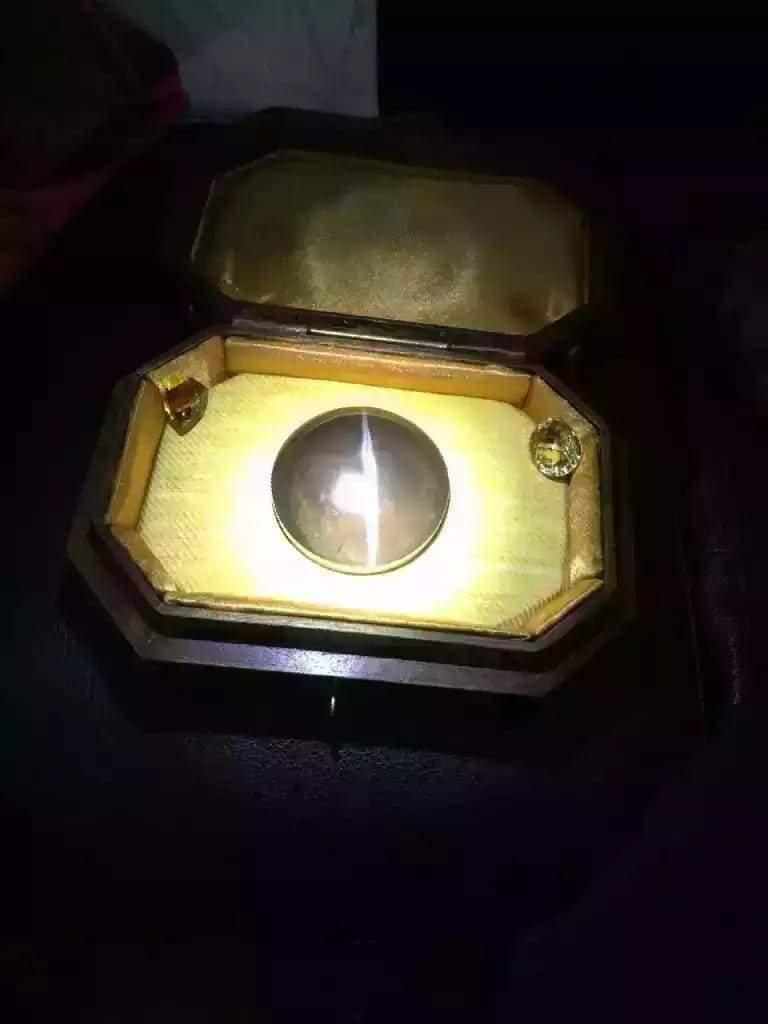
The Honey Brown 1611.8-carat gemstone is a breathtaking natural marvel, distinguished by its colossal size and deep, golden-brown hue. Weighing over 1,600 carats, this gem is a rare collector’s treasure, likely intended for museum display or high-value private collections. Its rich honey-brown coloration evokes warmth and earthiness, reminiscent of autumnal amber tones or the golden richness of aged whiskey.
Expertly cut and polished, the gemstone reveals a luminous surface with subtle internal reflections that enhance its depth and character. The impressive mass and visual appeal suggest it could be a variety of quartz, such as citrine or smoky quartz, although professional gemological analysis would determine its precise identity.
A symbol of nature’s grandeur and geological wonder, the Honey Brown 1611.8 ct gemstone stands as a showpiece of beauty, rarity, and timeless elegance.
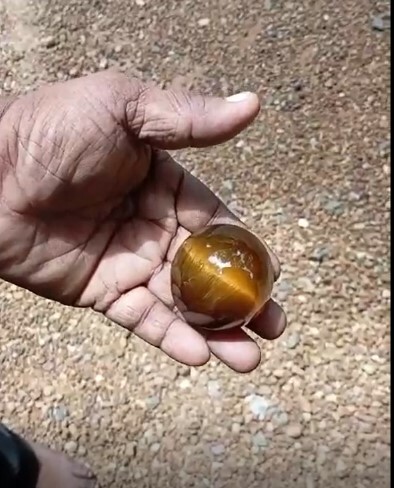
The Honey Brown 528.03-carat gemstone is a magnificent example of natural splendor and refined elegance. With its rich, warm golden-brown hue, this exceptional stone exudes an earthy luxury that is both grounding and radiant. The gem's impressive weight of 528.03 carats makes it a rare and significant specimen, likely intended for display, collection, or custom high-end jewelry.
Carefully cut to maximize its depth of color and clarity, the stone showcases brilliant internal reflections and a smooth polish that enhances its visual appeal. The honey-brown tone suggests it may be a variety of quartz, such as smoky quartz or citrine, though further gemological analysis would confirm its exact classification.
Whether admired for its sheer size, unique coloration, or natural beauty, the Honey Brown 528.03 ct gemstone is a striking piece that captures the essence of luxury and nature in perfect harmony.
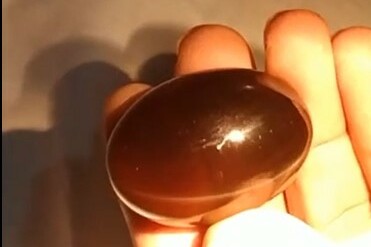
The Honey Brown Cat’s Eye and Star Sapphire, weighing an extraordinary 116.47 carats, is a rare and mesmerizing gemstone that combines two exceptional optical phenomena—chatoyancy (cat’s eye effect) and asterism (star effect). Exhibiting a rich honey-brown body color, this gem radiates a warm, golden luster that shifts with the light, creating a captivating visual experience.
Under direct illumination, a sharp, well-defined cat’s eye line glides smoothly across the stone’s surface, while a luminous star pattern—typically with six distinct rays—emerges in parallel, enhancing its rarity and allure. This dual phenomenon is incredibly uncommon, making the gem a true collector’s piece and a masterpiece of nature’s artistry.
Carefully cut as a cabochon to maximize both effects, the stone’s silky luster and internal structure reflect the precision and expertise behind its preparation. With its substantial weight and optical uniqueness, the Honey Brown 116.47 ct Cat’s Eye and Star Sapphire is not only a gem of great beauty but also a significant specimen of gemological rarity and intrigue.
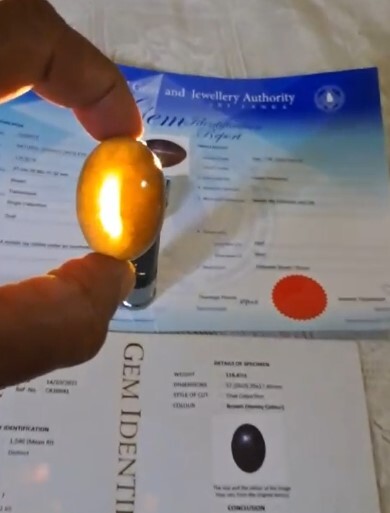
The Honey Brown Cat’s Eye and Star Sapphire, weighing an extraordinary 116.47 carats, is a rare and mesmerizing natural gemstone that showcases two exceptional optical phenomena—chatoyancy (the cat’s eye effect) and asterism (the star effect)—in a single stone. This unique combination is exceptionally uncommon, making this gem a true collector’s treasure.
Its rich honey-brown body color is both warm and earthy, with golden undertones that glow under light. When illuminated, a sharp, focused cat’s eye band dances across the surface, while a distinct star—typically six-rayed—emerges gracefully, shifting with the angle of the light. These phenomena are caused by fine, naturally aligned inclusions within the stone, expertly preserved and enhanced by a high-domed cabochon cut.
At 116.47 carats, this gemstone is not only remarkable for its optical rarity but also for its impressive size and presence. Whether intended for a high-jewelry statement piece or maintained as part of a prestigious gem collection, the Honey Brown Cat’s Eye and Star Sapphire is a true marvel of nature—rare, radiant, and unforgettable.

A Monumental Rarity of Elemental Beauty and Scientific Wonder**
Presenting an extraordinary geological specimen of both aesthetic allure and scientific significance — a Green Pollucite weighing an astonishing 12.35 kilograms. Towering above typical mineral samples in both mass and rarity, this specimen is not only a visual marvel but also a symbol of the Earth's rarest elements, frozen in crystal form.
With its subtle green hue and commanding presence, this Pollucite crystal is a natural treasure, holding immense value across gemological, scientific, and collector communities. It is a piece that bridges the gap between natural art and mineralogical rarity, embodying both beauty and elemental mystery.
Pollucite is a rare cesium-bearing mineral from the zeolite group, typically found in granitic pegmatites. It is the primary ore of cesium, a strategic and highly reactive alkali metal used in atomic clocks, space-grade electronics, and high-frequency communications.
While Pollucite is often seen in colorless or milky white forms, a green-hued Pollucite is an exceptionally rare variant — almost never encountered in this magnitude and clarity. This 12.35 kg specimen is therefore both an aesthetic anomaly and a scientific gem, rarely seen even in elite geological collections.
This specimen boasts a soft, translucent green hue, subtly reminiscent of prehnite or chrysoberyl, but with a unique, glassy brilliance that sets Pollucite apart. The color is caused by trace elements and mineral inclusions during its formation, giving the stone an ethereal, luminous quality.
Color: Pale to medium translucent green, evenly distributed
Clarity: Semi-transparent with internal crystalline structures
Luster: Vitreous to greasy — highly reflective under light
Crystal Habit: Typically massive, with occasional crystalline faces visible
The surfaces of the specimen display natural geometric formations, characteristic of pegmatitic growth environments, with minimal weathering or surface damage, further emphasizing the quality and preservation of the piece.
Weighing 12.35 kilograms (27.23 pounds), this Pollucite specimen is not only monumental in scale, but also exceptionally rare. Most Pollucite specimens weigh just a few grams to hundreds of grams. Crystals exceeding even one kilogram are extremely rare. This stone, at over 12 kilograms, qualifies as a museum-grade specimen — possibly one of the largest green Pollucites documented in private or institutional collections.
This immense size allows detailed visual study of its crystalline structures and internal zoning, making it invaluable for educational, research, and display purposes.
Pollucite’s importance in science stems from its role as the primary source of cesium (Cs). Cesium is vital for:
Atomic clocks (the world’s most precise timekeeping instruments)
Oil and gas drilling fluids (due to its high density)
Ion propulsion systems in aerospace applications
Medical and industrial imaging devices
While most cesium used industrially is extracted from Pollucite through complex refining processes, gem-grade or collector-quality Pollucite — particularly colored variants — are preserved for their natural beauty and rarity.
This specimen, however, straddles both worlds: scientific significance and collector-grade rarity.
Though Pollucite has been discovered in select global locations — including Manitoba (Canada), Utah (USA), Afghanistan, and the Tanco Mine in Manitoba (the world's largest cesium deposit) — green-hued varieties are almost exclusively associated with highly evolved pegmatites, and are seldom encountered in this form.
If the provenance of this specimen is known, it could further elevate its rarity, especially if traced to a closed or depleted mine.
Due to its rare green coloration and cesium-bearing nature, this Pollucite holds symbolic and energetic appeal:
Green crystals are often associated with renewal, healing, and balance.
In metaphysical contexts, Pollucite is believed to promote detoxification, clear electromagnetic interference, and support higher frequency alignment — ideal for energy workers and collectors alike.
To mineral collectors, this specimen represents:
A cornerstone of advanced mineralogy
A link between the earth’s deep geological processes and human technology
A conversation piece of epic proportions
Given its weight, quality, and aesthetic presence, this specimen is best suited for:
Museum exhibitions showcasing rare or technologically significant minerals
University geology departments for research and educational study
Luxury interior design as a one-of-a-kind natural sculpture
High-end private collections focused on rare earth elements or large specimens
Proper lighting will dramatically enhance the gem’s internal glow and green hue, especially under halogen or LED with a daylight spectrum. A rotating pedestal or lucite display base would offer a perfect platform for this geological giant.
The Green Pollucite – 12.35 kg specimen is a once-in-a-lifetime discovery. Monumental in size, unusual in color, and rich in scientific, aesthetic, and metaphysical value, it is a perfect synthesis of Earth’s artistry and elemental power. Whether admired for its soft green glow, valued for its cesium content, or displayed as a natural sculpture, this Pollucite is a testament to nature's ability to produce the rarest and most beautiful materials beneath our feet.
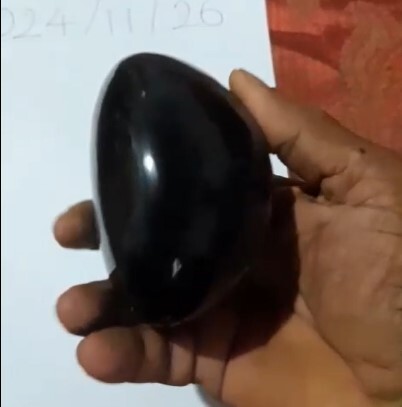
The Black Tourmaline, weighing an extraordinary 4,530 carats (approximately 906 grams), is a commanding example of nature’s raw power and protective energy. Known for its deep, inky black color and strong grounding properties, this massive specimen is both a geological marvel and a metaphysical powerhouse.
Displaying a natural luster with fine striations along its surface, this tourmaline crystal exhibits the classic columnar structure that is characteristic of the species. Its bold, opaque black tone absorbs light, giving it a dramatic presence that is ideal for collectors, display purposes, or spiritual use.
Black Tourmaline is highly regarded in both gemology and holistic practices for its ability to repel negative energy and provide emotional stability. In this extraordinary size, the 4,530 ct stone becomes more than a gem—it becomes a centerpiece, a statement, and a symbol of strength and grounding.
Whether showcased in a museum, used as a focal point in interior decor, or held for its energetic properties, this monumental Black Tourmaline is a rare and captivating treasure from the Earth’s depths.
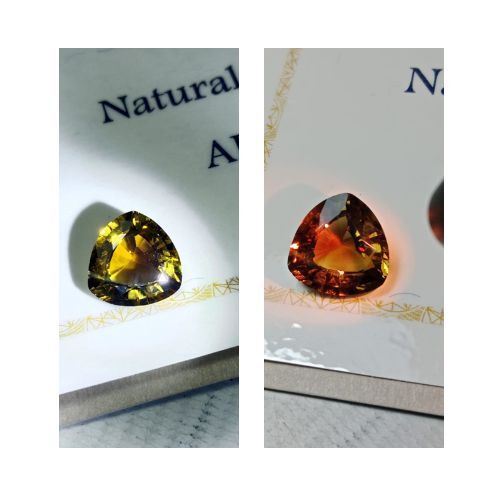
The 10.75-carat Alexandrite is a truly rare and extraordinary gemstone, celebrated for its remarkable color-change phenomenon and high value among collectors and connoisseurs. Under natural daylight, this gem displays a rich green to bluish-green hue, while under incandescent or warm artificial lighting, it dramatically transforms into a deep purplish-red to reddish-violet tone. This magical shift—often described as “emerald by day, ruby by night”—makes Alexandrite one of the most coveted and mysterious gems in the world.
At 10.75 carats, this specimen is exceptionally large for natural Alexandrite, which is typically found in much smaller sizes. Expertly faceted to enhance both brilliance and the intensity of its color change, the gemstone boasts excellent clarity and symmetry, further elevating its rarity and appeal.
First discovered in Russia’s Ural Mountains and now sourced only from a few locations globally, high-quality Alexandrite of this size and optical performance is a true gemological treasure. Whether destined for fine jewelry or preserved as a collector’s piece, this 10.75 ct Alexandrite is a stunning example of nature’s artistry—vivid, dynamic, and unforgettable.
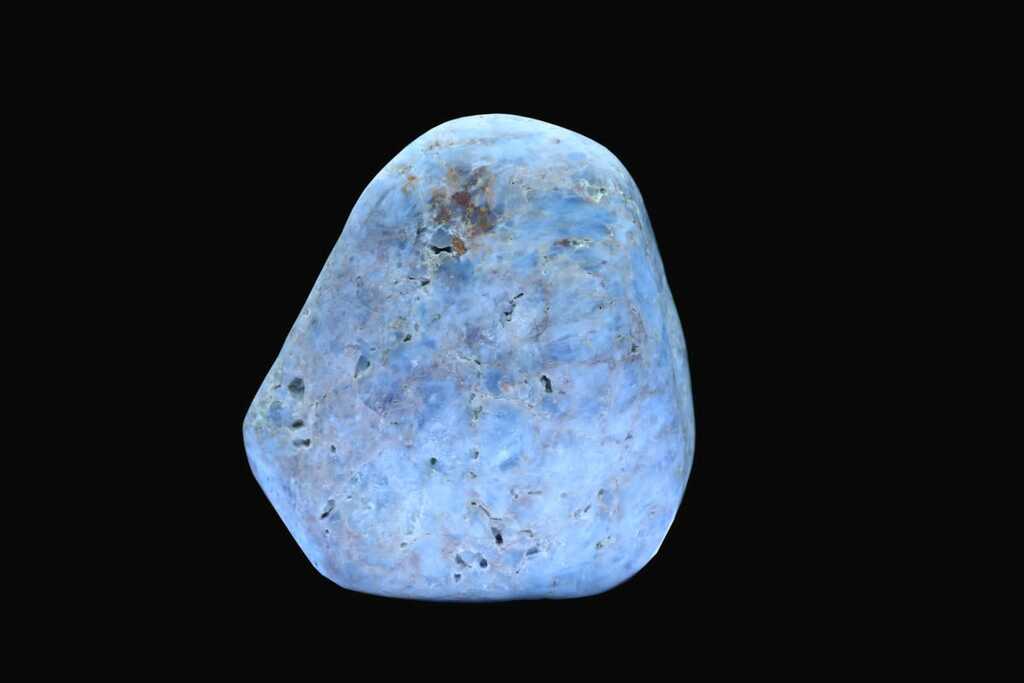
The Milky Blue Sapphire, weighing an astonishing 52 kilograms, is a monumental and extremely rare gemstone specimen. Displaying a soft, opalescent blue hue with a gentle milky translucence, this sapphire possesses a serene and ethereal beauty that sets it apart from more common transparent varieties. The calming pastel tone, combined with its massive size, gives the stone a striking presence—ideal for museum exhibitions, high-profile collections, or gemological study.
This sapphire’s “milky” appearance is likely due to microscopic inclusions or internal structures that scatter light, producing a glowing, diffused effect across its surface. Despite the lack of transparency, this optical quality adds a unique character and charm, making it a visually engaging and highly valued collector's piece.
As one of the heaviest known specimens of its kind, the 52 kg Milky Blue Sapphire is not only a testament to natural geological processes but also a symbol of rarity and raw beauty. Its sheer scale and distinctive color make it a captivating centerpiece in any setting.
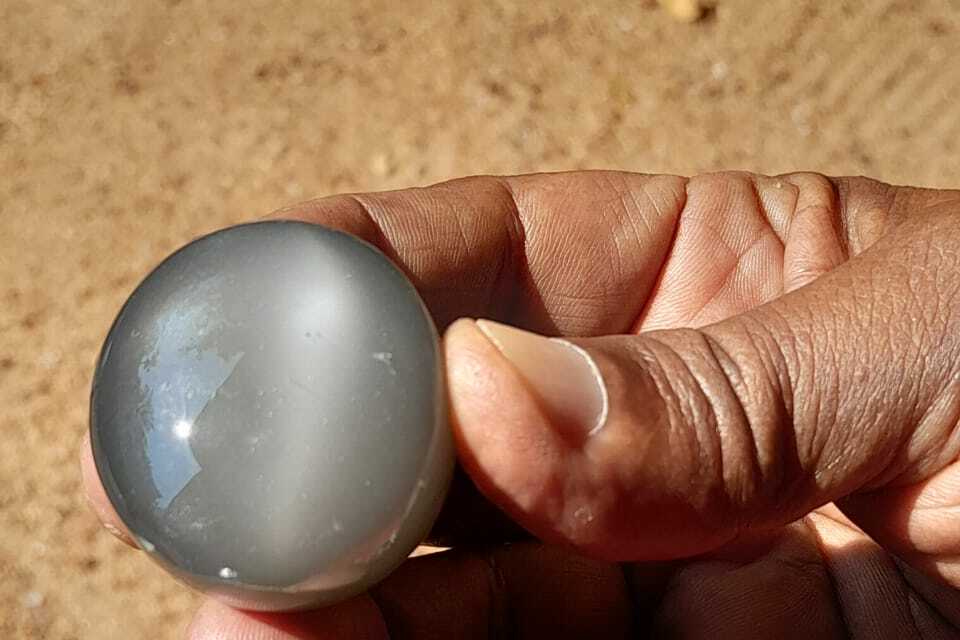
The Moonstone Cat’s Eye, weighing an impressive 246.6 carats, is a stunning and rare gemstone that captivates with its soft glow and striking optical phenomena. Exhibiting a silvery, milky sheen with a distinct cat’s eye effect—known as chatoyancy—this gem reveals a luminous, narrow band of light that glides smoothly across the surface as it moves under illumination.
Its body color ranges from pearly white to subtle bluish or grayish tones, enhancing its ethereal quality and moon-like radiance. The cat’s eye effect, caused by fine needle-like inclusions aligned within the crystal, gives this large moonstone both visual intrigue and symbolic depth.
At 246.6 carats, this gemstone is exceptionally large for a moonstone, making it a rare collector’s item or centerpiece for a bold, one-of-a-kind jewelry design. Moonstones are revered in many cultures for their connection to intuition, femininity, and emotional balance, and the addition of the cat’s eye effect elevates this piece into a realm of mystical allure and natural artistry.
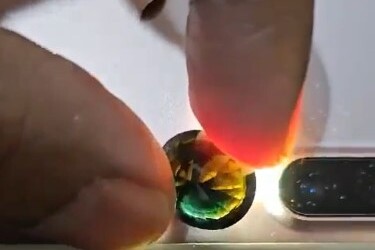
A Celestial Gem of Rare Magnitude and Mesmerizing Beauty**
Behold a gemstone of profound rarity and mystical allure — the Natural Blue Star Sapphire, weighing an extraordinary 331.85 carats. This majestic gemstone is a true marvel of nature, revered for its celestial asterism, hypnotic luster, and exceptional size. As one of the most sought-after and legendary gems in the world, the star sapphire is a stone that fuses optical wonder with historical prestige, and this specimen stands among the finest examples of its kind.
At the heart of this gemstone's enchantment lies its distinct six-rayed star, a rare optical phenomenon known as asterism. When exposed to a direct light source, a radiant, silken star dances across the domed surface of the cabochon, appearing to hover just above the gem — a dynamic interplay of light and crystal. This effect is caused by microscopic rutile needle inclusions, precisely aligned within the stone's structure. The star, crisp and centered, gracefully glides as the gemstone is rotated, giving the illusion of movement within the gem’s depths.
The visibility and sharpness of this sapphire’s star place it in the upper echelon of star sapphires. Unlike lesser specimens with faint or distorted patterns, this gemstone exhibits a well-defined, symmetrical six-ray star, perfectly centered, and glowing against the vibrant blue backdrop.
This Natural Blue Star Sapphire displays a rich, velvety blue hue — deep yet vibrant, echoing the colors of twilight skies. Its saturation is even and unclouded, with minimal interference from other mineral traces, allowing the star phenomenon to shine clearly against its mesmerizing blue base. The body color enhances the stone's regal quality, embodying the traditional elegance for which blue sapphires are famed.
Color: Deep royal blue with subtle silken sheen
Clarity: Semi-translucent, characteristic of natural star sapphires
Luster: Silky and luminous
Cut: High-domed cabochon — the optimal shape to reveal strong asterism
The surface of the gem has been expertly polished to reveal its internal marvels while retaining the natural character that distinguishes it from synthetic or overly treated stones.
At 331.85 carats, this star sapphire is a gem of museum-worthy proportions. Most star sapphires on the market range from 5 to 50 carats. A specimen of this colossal weight, combined with such vivid color and well-defined asterism, is extremely rare — a true collector’s treasure.
Such significant size offers presence and impact, whether kept as an investment-grade loose gemstone or transformed into a bespoke centerpiece for high jewelry. Its sheer weight and quality elevate it to the realm of heirloom gemstones, destined to be passed down through generations or displayed in elite gem collections.
This stone is 100% natural, unheated, and untreated — a vital distinction for serious gemologists and collectors. While heat-treated star sapphires are common in the market, untreated specimens with such clear asterism and uniform color are exponentially more valuable and rare.
Though the exact origin of this particular specimen may require gemological testing, star sapphires of this caliber often hail from prestigious sapphire-producing regions such as Sri Lanka (Ceylon), Myanmar (Burma), or Thailand — all known for their historic deposits and centuries-old legacy of sapphire mining.
Across cultures and eras, star sapphires have held symbolic meaning as stones of destiny, believed to offer divine protection, guidance, and good fortune to their bearer. The star was seen as a celestial compass, guarding travelers and spiritual seekers. In ancient lore, the three crossbars of the star represented faith, hope, and destiny.
In metaphysical traditions, blue star sapphires are associated with:
Mental clarity and wisdom
Spiritual insight and protection
Enhanced intuition and inner strength
Their association with the throat chakra also makes them a symbol of truth and communication, further amplifying their personal and energetic significance.
A gemstone of this stature is typically reserved for:
High jewelry commissions — such as custom-designed brooches, pendants, or ceremonial rings
Museum display or high-end gem showcases
Investment portfolios of rare and appreciating gemstones
Royal and elite private collections
Given its size, symmetry, and visual appeal, this sapphire would be equally stunning displayed in a custom-lit presentation case, highlighting its star under controlled lighting to mesmerize all who view it.
The Natural Blue Star Sapphire – 331.85 carats is not merely a gemstone; it is a celestial phenomenon locked in stone. From its exquisite six-rayed star to its exceptional color and unparalleled weight, this gem stands as a testament to nature’s artistry and rarity. Whether admired for its beauty, held for its spiritual significance, or treasured as a historical and geological marvel, this sapphire is a timeless symbol of elegance, mystery, and cosmic wonder.
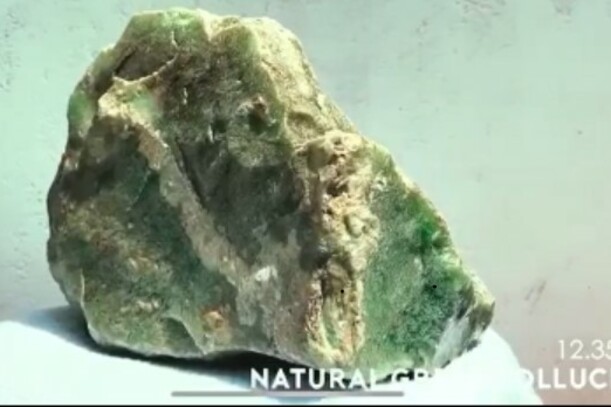
The Pale Green Emerald weighing 243.91 carats is a magnificent gemstone that embodies subtle elegance and natural beauty. Unlike the intense forest-green hues of traditional emeralds, this rare specimen features a soft, translucent pale green color that exudes a serene and sophisticated charm. Its gentle tone, reminiscent of spring leaves or morning dew, highlights the stone’s purity and unique character.
With a substantial weight of 243.91 carats, this emerald is a significant specimen, ideal for collectors, gem enthusiasts, or display in a high-end collection. The gem has been shaped and polished to accentuate its natural luster while preserving the delicate internal features—commonly referred to as the jardin—that are characteristic of emeralds and add to their authenticity and organic appeal.
Such a large pale green emerald is uncommon and highly prized for its distinctive hue, making it a rare treasure that reflects the calming essence of nature combined with the timeless prestige of one of the world’s most valued gemstones.
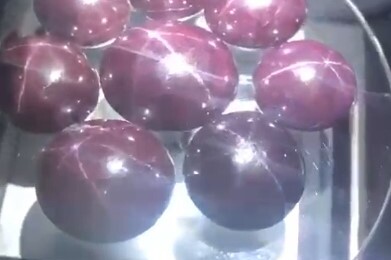
This exquisite collection of Star Garnets, ranging in weight from 93.23 to 79.19 carats, showcases the rare and captivating beauty of a unique garnet variety known for its distinct asterism. When viewed under a focused light source, each gemstone reveals a well-defined, star-like pattern—typically four-rayed, though occasionally six-rayed—caused by microscopic rutile inclusions aligned within the crystal structure.
Exhibiting deep, rich tones—often appearing dark reddish-purple to deep wine—the star effect adds a magical, almost celestial glow to these powerful gemstones. Expertly shaped into smooth cabochons, the surface of each garnet has been carefully polished to enhance the visibility and movement of the star as the stone is turned.
Star Garnets of this size and clarity are extremely rare, with deposits found in only a few parts of the world, such as India, Sri Lanka, and Idaho (USA). Their bold coloration, combined with their mystical star phenomenon, makes them prized by collectors, jewelers, and gem enthusiasts alike.
These gems not only captivate the eye but are also believed to carry grounding and revitalizing energies, making them both a visual and metaphysical treasure.
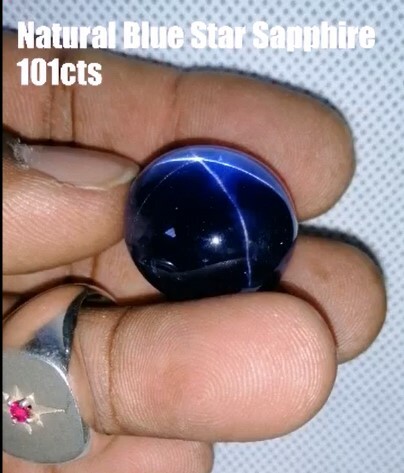
The Natural Blue Star Sapphire, weighing an impressive 101.54 carats, is a rare and captivating gemstone renowned for its striking asterism—a natural star-like pattern that appears to float on its surface. This optical phenomenon, caused by aligned needle-like inclusions of rutile, reveals a radiant six-rayed star when viewed under direct light, moving gracefully as the stone is turned.
With a deep royal to velvety blue body color, the sapphire exudes elegance and mystique, embodying both power and serenity. Expertly cut in a high-domed cabochon to enhance the star effect, the gem showcases a smooth, polished surface that highlights the clarity and sharpness of the star.
Such large, natural, untreated star sapphires are exceptionally rare, making this 101.54 ct specimen a valuable addition to any fine gemstone collection or high-jewelry masterpiece. Its combination of size, color, and optical beauty makes it a true gemological treasure.

The Dark Green Serendibite, weighing 9.15 carats, is a rare and captivating gemstone known for its exceptional rarity, rich color, and gemological intrigue. Exhibiting a deep forest-green hue with subtle undertones of bluish-black, this stone carries a mysterious, almost velvety appearance that reflects both elegance and strength.
Originating from only a few known deposits in the world—primarily Sri Lanka and Myanmar—Serendibite is among the rarest gemstones ever discovered. This 9.15 ct specimen is not only notable for its size, but also for its clean cut and polished finish, which reveal a dense, opaque to slightly translucent body with a subtle internal glow when viewed under strong light.
Highly sought after by collectors and connoisseurs, Serendibite is a gem of legend and prestige. Its dark green variety is even less common, making this piece a unique addition to any high-value gemstone collection or bespoke jewelry creation.

The Pushparaga, or Yellow Sapphire, weighing an impressive 220 carats, is a gemstone of exceptional beauty and significance. Known for its vibrant golden-yellow hue, this large and luminous sapphire radiates warmth, prosperity, and divine energy. The term Pushparaga—derived from Sanskrit—translates to “the color of a flower,” and this gemstone lives up to its name with its rich, sun-kissed tone reminiscent of blooming marigolds or golden lotus petals.
Cut and polished to enhance its brilliance, the 220 ct Pushparaga exhibits a glowing translucence with flashes of internal fire, making it a striking visual centerpiece. Yellow sapphires of this size and quality are extremely rare, often sought after for astrological significance in Vedic traditions, where they are associated with Jupiter (Guru) and believed to bring wisdom, wealth, and spiritual growth.
Whether admired for its size, symbolism, or radiant beauty, this Pushparaga stands as a magnificent example of natural elegance and metaphysical allure—ideal for collectors, connoisseurs, or as a high-value statement stone in bespoke jewelry.
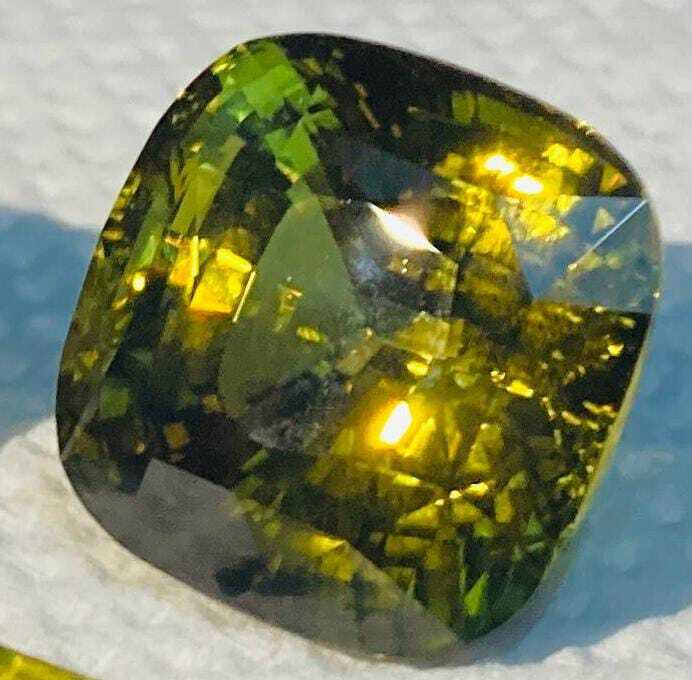
Natural Chrysoberyl Alexandrite: A Rare and Enigmatic Gemstone
One of the rarest and most fascinating gemstones in nature is natural chrysoberyl alexandrite. Since its discovery in the 19th century, this remarkable gem—a variety of the mineral chrysoberyl—has enthralled gem enthusiasts, collectors, and royalty alike with its extraordinary optical phenomenon—color change. Natural alexandrite, as opposed to artificial or laboratory-grown varieties, is a true geological wonder that was created under extreme heat and pressure deep within the Earth's crust.
Origin and Geological Formation
Chrysoberyl is a durable mineral composed of beryllium aluminum oxide (BeAl₂O₄). Alexandrite is a unique variety of chrysoberyl that owes its striking color change to the presence of trace amounts of chromium. These chromium atoms absorb certain wavelengths of light in such a way that the gemstone appears green in daylight or fluorescent light and red to purplish-red in incandescent light. This rare combination of geological factors makes alexandrite exceptionally rare.
Alexandrite was first discovered in the Ural Mountains of Russia in the early 1830s. Named after the young Czar Alexander II, the gemstone’s red and green hues also mirrored the imperial Russian military colors, adding to its allure and symbolism. Since then, other deposits have been found in Brazil, Sri Lanka, Tanzania, India, Madagascar, and Myanmar, though fine-quality alexandrite remains extremely scarce.
The Phenomenon of Color Change
The most celebrated feature of natural alexandrite is its dramatic and distinctive color change. Under daylight or fluorescent lighting, the gemstone displays hues of bluish-green to emerald green. Under incandescent or candlelight, it shifts to shades of reddish-purple, raspberry, or garnet-red. This optical trait is so pronounced that it gave rise to the poetic phrase:
“Emerald by day, ruby by night.”
This phenomenon is due to alexandrite’s unique absorption spectrum, which allows the gem to reflect different colors depending on the light source. The more distinct and dramatic the color change, the more valuable the gem.
Physical and Optical Properties
Hardness: 8.5 on the Mohs scale (second only to sapphire and diamond)
Luster: Vitreous (glass-like)
Refractive Index: 1.746–1.755
Birefringence: 0.008–0.010
Crystal System: Orthorhombic
Cleavage: Distinct
Specific Gravity: 3.68–3.78
These physical properties make alexandrite not only beautiful but also suitable for everyday wear in jewelry such as rings, earrings, and pendants.
Symbolism and Metaphysical Beliefs
Throughout history, alexandrite has been associated with mysticism, transformation, and balance. Its changing color is seen as a metaphor for personal growth and adaptability. It is said to bring good fortune, enhance intuition, and foster emotional resilience.
In crystal healing and metaphysical circles, alexandrite is believed to stimulate the crown and heart chakras, harmonizing intellect and love. It is also considered a stone of joy and self-confidence.
Alexandrite is the birthstone for June (along with pearl and moonstone) and is often gifted on 55th wedding anniversaries as a symbol of enduring love and commitment.
Rarity and Value
Natural alexandrite is among the most expensive gemstones in the world, particularly when the color change is strong and the stone is free of inclusions. Fine specimens can command prices higher than diamonds or sapphires of comparable size. Even small, top-quality alexandrites (under 1 carat) can be extremely valuable.
Gemstone collectors often seek alexandrite not only for its beauty but for its rarity and investment potential. Synthetic alexandrite and simulants exist, but they do not match the natural stone’s optical complexity or geological heritage.
Conclusion
Natural Chrysoberyl Alexandrite is a gemstone like no other. With its rare geological formation, spellbinding color change, and deep cultural and metaphysical significance, it stands as a symbol of transformation, rarity, and elegance. Whether worn as a treasured piece of jewelry or kept as a collector's gem, alexandrite continues to fascinate and inspire, holding a timeless place among the world’s most coveted gemstones.